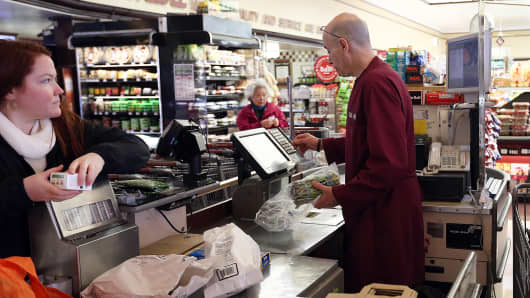Find it here: http://www.cnbc.com/id/101589514?__source=xfinity|mod&par=xfinity
--Kim
Behind the cornucopia of higher food prices
John W. Schoen| @johnwschoen15 Hours Ago
705
COMMENTSJoin the Discussion
Alert shoppers are accustomed to watching food prices go up and down. But a string of forcesfrom droughts to diseasesis raising the cost of a trip to the grocery store at a rapid clip.
And it looks like it will be a while before the price pressure eases.

Getty Images
A clerk rings up a customer at Cal-Mart Grocery on March 27, 2014 in San Francisco, California.
Some of that pressure is coming from Californiathe source of roughly half the nation's fruits and vegetableswhere a long-running drought is forcing farmers and ranchers to cut production. After the driest year on record, large sections of farmland are expected to lay fallow this year as the Golden State copes with an ongoing water crisis
Read More Your food, your wallet and the California drought
That could have "large and lasting effects on fruit, vegetable, dairy and egg prices," according to a recent USDA report, which said the full impact has yet to be felt.
Smaller cattle herds have forced meat prices higher in Marchup more than 5 percent from a year ago, as demand remained strong despite tightener supplies. Ranchers are getting higher prices for cattle and food companies are able to pass them along.
Learn About Tableau
[there are some graphics that go here, but they didn't copy. Go to the site to see them.]
Pork prices also have been rising after higher feed costs last year forced hog farmers to cut production. The upward price pressure on pork intensified this winter when a deadly virus thinned pig herds. That's expected to bring even higher prices for this summer's grilling season, when demand typically picks up.
Read MoreHold the bacon: Breakfast staples face surging prices
"I think consumer should expect record high meat prices his year," Tyson Foods CEO Donnie Smith told CNBC last month. "You should expect to see very high prices for your ground beef, your other meat cuts, all the pork cuts will be higher this year."
Food prices are notoriously volatile, subject to short term spikes and drops based on weather-related shortages and surpluses. But the forces at work this year are longer-lasting.
An ongoing contraction in the U.S. dairy herd, for example, is pushing up retail prices of cheese, ice cream, and other processed dairy foods.
Read MoreWhy inflation is hard to swallow for food companies
Farm egg prices have been among the most volatile, jumping by 20 percent in February after dropping by 28 percent in January.
U.S. farmers aren't the only ones facing a production squeeze. A drought in coffee growing regions of southern Brazil, the world's largest coffee producer, has pushed up the cost of a cup of Java worldwide. Coffee futures have surged 57 percent this year and rose above $2 a pound last month for the first time in two years.
With bacon and coffee prices surging, breakfast is becoming more expensiveespecially if you include a glass of orange juice. Future prices are up 12 percent this year, hitting two-year highs, after Florida's orange crop was hit by an insect-borne disease that's expected to cut yields to the lowest levels in nearly a quarter century. Production could fall by about 15 percent to 114 million boxes this year, according to government forecasts, the lowest level since 1990.The recent series of food price hikes follow a relatively long stretch of stable consumer prices. Since 1990, retail food prices have risen by an average of 2.8 percent a year, according to USDA. From February through December of last year, average supermarket prices fell by 0.2 percent.
Read More Farm bill: Bring on the hemp and sushi rice!
Consumers are also coping with higher costs beyond their supermarket shopping cart. After a brutal winter in much of the country kept shoppers home, a pickup in demand has sent clothing and used car prices higher in March.
Rents are also going up in most of the country, up 2.7 percent in the latest 12-months, a pace not seen since the housing market collapsed in 2007. Medical costs are also rising.
Because food prices are typically more volatile than other consumer costs, economists and policy makers at the Federal Reserve usually ignore them when looking at the so-called "core rate" of inflation. But after a long period of inflation running less than 2 percent a year, the latest surge in prices bears closer watching, according to Capital Insight senior economist Paul Dales.
"We suspect that core inflation will rise to 2 percent this year and beyond it next year, which would catch the Fed off guard," he wrote in a recent note to clients..
By CNBC's John Schoen. Follow him on Twitter @johnwschoen or email him.



No comments:
Post a Comment